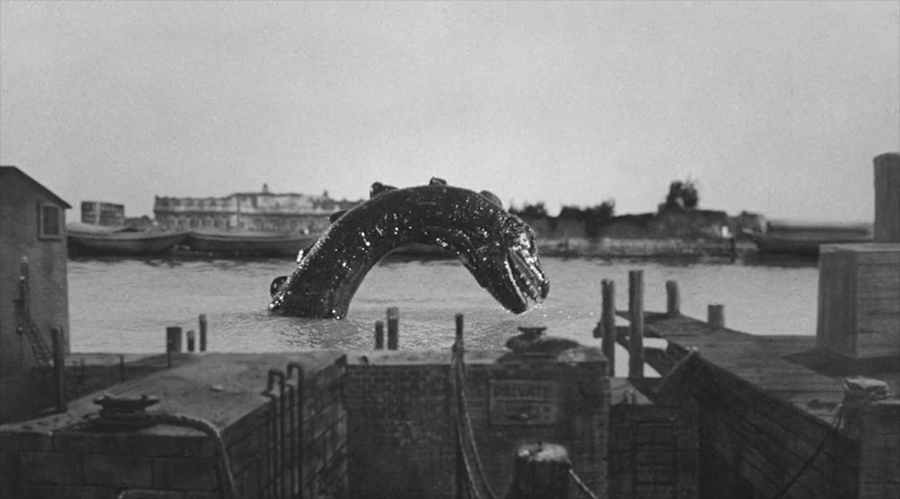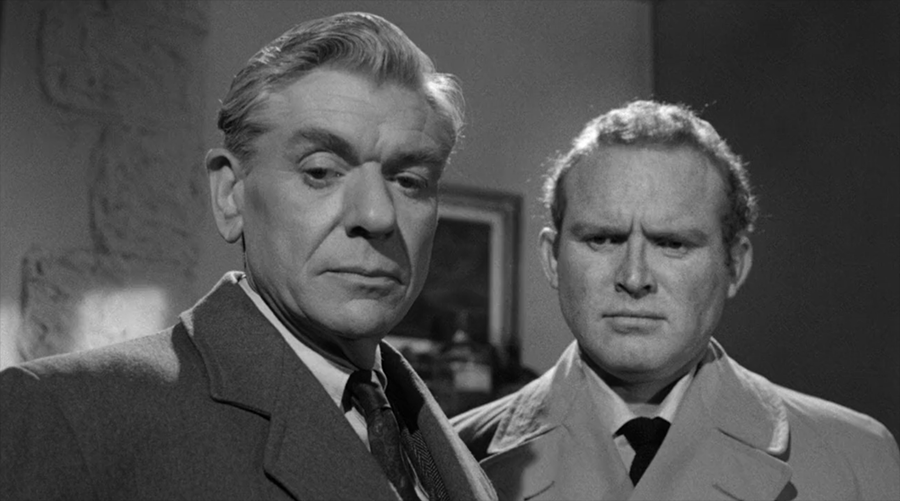THE GIANT BEHEMOTH
Directed by Eugène Lourié. 1959. United Kingdom. United States.

In Cornwall, a fisherman is killed by a mysterious surge of radiation. His final words herald the arrival of a great terror. “From the sea… Burning like fire… Behemoth!”. Meanwhile, marine biologist Steve Karnes lectures at a meeting of a British research society. He tells them about the 43 atomic tests made since the invention of the bomb and of the “biological chain reaction” occurring in nature. Animals feast on irradiated animals, eventually ending up on our dinner tables. The Lucky Dragon No. 5 incident is mentioned.
After the meeting convenes, we meet Professor Bickford and learn that thousands of dead fish are washing up on shore. Even more concerning are stories of sea monster sightings of the “Loch Ness variety”, claims any rational scientist would think are absurd. But this is a 1950s science fiction movie, so off we go to investigate. Samples of dead fish are collected, and we observe, almost in real time, as the samples are tested for nuclear contamination. Sure as shit, some of the fish are downright glow-in-the-dark.
Reports of the potential sea monster lead Karnes to travel out to sea. He catches a glimpse of the beast rolling in the waves. After something large and dangerously radioactive attacks a farm in Essex, a massive footprint is found. A paleontologist identifies the print as belonging to a Paleosaurus, a semi-aquatic dinosaur capable of emitting a surge of electricity, much like an electric eel. The scientists surmise that this dinosaur was exposed to a staggering amount of radiation as a result of all those nuclear tests. The bodies found burnt to a crisp by radiation were caused by the Paleosaurus no longer emitting a surge of electricity, but a highly concentrated dose of nuclear radiation.
Thankfully, the beast cannot live for much longer with that amount of radiation flowing through it. That’s the upside. The downside is that the monster is heading back to shallow waters, which puts it on a collision course with London and the millions of innocent people who live there. Our scientific duo comes up with a plan. Bombs would splatter the beast’s radiation-filled flesh all over the River Thames, but what if they could fire a radium-enriched torpedo right into the gaping maw of the behemoth? If the Paleosaurus were underwater, the impact would be lessened, but the added dose of nuclear poison just might put an end to the nightmare.
THE GIANT BEHEMOTH was directed by Eugène Lourié, and it shows. The similarities between it and Lourié’s 1955 blockbuster THE BEAST FROM 20,000 FATHOMS are undeniable. Worse, they’re consistently distracting. THE GIANT BEHEMOTH doesn’t just stop at visually referencing Lourié’s earlier success. It lifts its every moment from GODZILLA, IT CAME FROM BENEATH THE SEA, and… Well, basically every giant monster movie made during that decade. I imagine people who discover THE GIANT BEHEMOTH early in their journey through the lands of rampaging nuclear monsters and kaiju terrors will respond more favorably to it. For more well-worn travelers like myself, there’s precious little that we’ve not seen dozens of times before.

It annoys me that what began life as the story of an amorphous blob of nuclear goo was changed into yet another big monster movie. Granted, we already had a blob in THE BLOB just a year prior, but I could have gotten behind another one of those instead of another one of these. Don’t get me wrong, there’s nothing I love more than a big, cranky monster laying waste to densely populated urban areas, but THE GIANT BEHEMOTH is so close to THE BEAST FROM 20,000 FATHOMS that it almost feels like plagiarism. That film is a masterpiece of 1950’s pop sci-fi. If you can’t do it better, don’t do it at all.
And make no mistake, nothing is done better here. Because the giant monster film had been around for so long, putting off the monster reveal until the 50-minute mark is a terrible mistake. There’s no chance that the reports of a giant monster are false, so why screw around with five-minute-long scenes of fish being filleted and tested for radiation? Just do that shit off-screen. Worse, when the monster does finally show up, it’s just a rubber sea serpent head knocking over toy boats. We need to wait another ten or so minutes before the monster comes on shore and starts wrecking the city.
Thankfully, once the Paleosaurus shows up in all its stop-motion glory, it is a sight to behold. Yes, it does just look like a longer-necked Rhedosaurus, and yes, most of its scenes are directly culled from THE BEAST FROM 20,000 FATHOMS and GODZILLA, KING OF THE MONSTERS, but Willis O’Brien’s wonderful stop-motion animation is glorious to watch. The beast looks tremendously frightening, and the way it routinely (and passively) turns hordes of onlookers into crispy corpses is the icing on the cake. While the scale of the devastation doesn’t reach kaiju levels, the time we spend with the Paleosaurus in London is truly great.
What all this means is that THE GIANT BEHEMOTH is not a film worth watching in its entirety. The first 50 minutes are mind-numbingly slow, and although Gene Evans and André Morell are both quite good in their roles, neither Karnes nor Bickford is all that interesting as a character. They are exposition machines, explaining all this nonsense while they (and we) wait for the monster to make its way to London. No, don’t watch this film in its entirety, and instead just skip forward an hour so you can watch Willis O’Brien do what he does best. The monster mayhem is classic stuff. Were the first 50 minutes as good as the final 20 minutes, THE GIANT BEHEMOTH would have been one of the greats. Alas, it’s just another one.